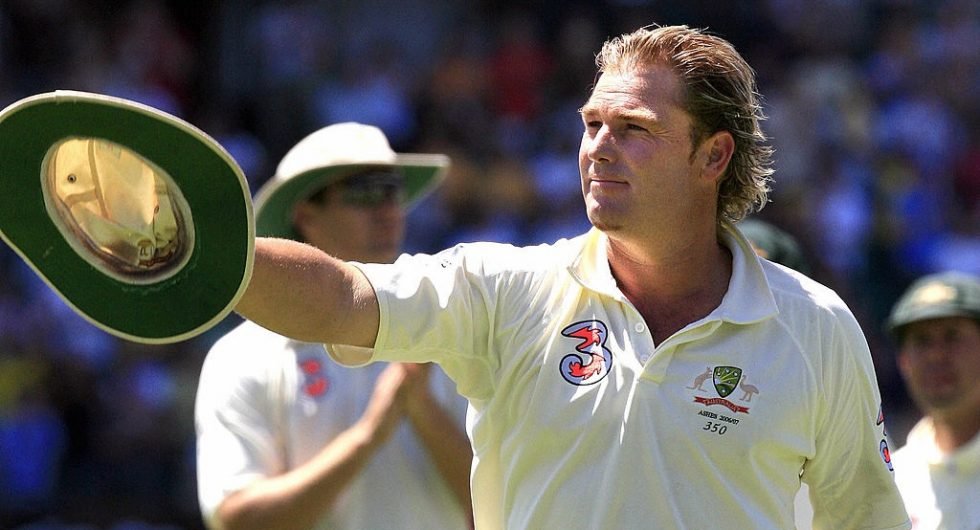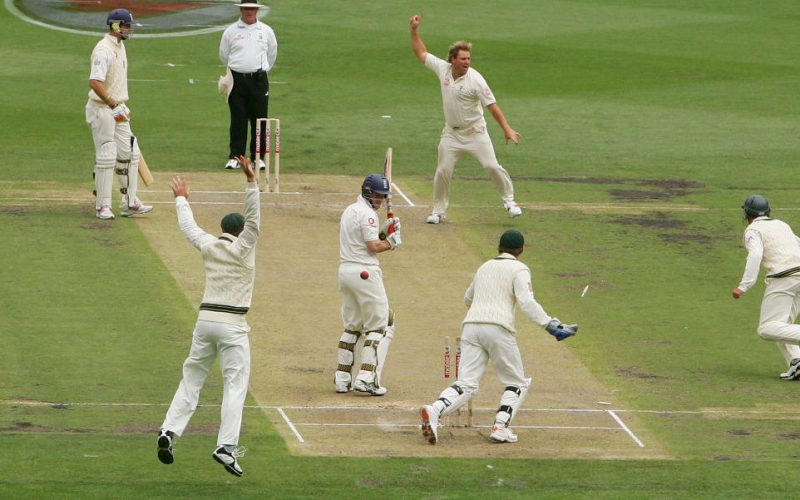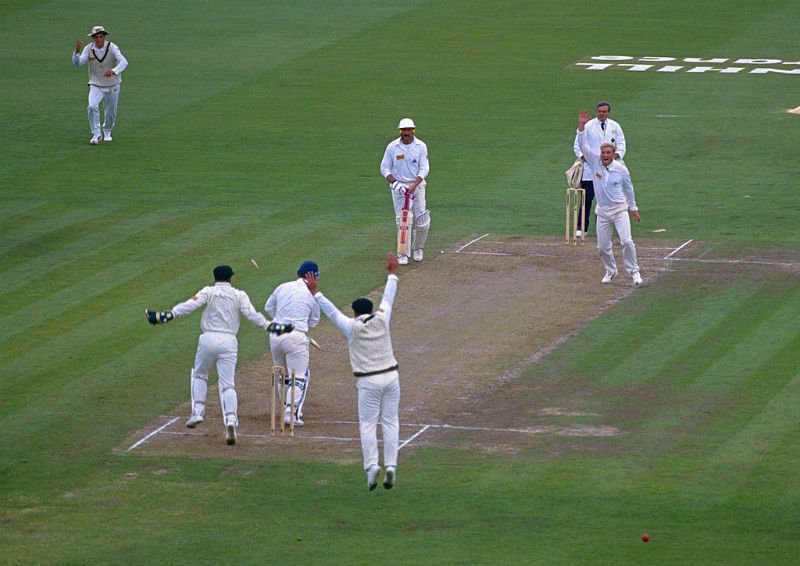Shane Warne: A genius craftsman and an entertainer – Almanack

Shane Warne celebrates his 50th birthday on September 13. When he retired in 2007, Mike Atherton paid tribute to the career of his longtime opponent.
In the moments after the Ashes were won at Perth in December 2006, only one of the victors managed the moment with due dignity. As the Australians hugged each other and celebrated with the crowd, England’s players, who had emerged to shake their conquerors’ hands, were ignored. Only Shane Warne broke away from the pack to acknowledge the vanquished.
At the end of the next Test, at the MCG, I was waiting near the podium to interview Warne, chivying him along because we were about to go off air. He started to walk over to me, then stopped. Andrew Flintoff was in the process of answering the usual post-match questions. Warne took off his cap, listened to Flintoff, applauded when Flintoff had finished, and then continued on his way towards me.

Shane Warne celebrates bowling England batsman Andrew Strauss to reach 700 Test wickets
If anyone had an excuse to be self-obsessed at the MCG it was Warne, but his respect for the game, and for the people who play it, was an essential and often overlooked part of his greatness. Michael Vaughan touched on this point in his book, A Year in the Sun. He said that Warne was “great to face because he gives you respect. If you do well against him he is not one to give you abuse. He will just say ‘shot’ and, after the game or your innings, he will come in and say ‘well played.’
“It is true that such respect has not always been in evidence (contrast his behaviour at the end of the 2006-07 series with his loutish celebrations from the Trent Bridge balcony in 1997), but they are the reasons why Warne the showman and Warne the celebrity never quite consumed Warne the cricketer. He never forgot that he was but one link in an Australian leg-spinning chain that goes back generations. He never forgot that he was a craftsman as well as an entertainer.
Wisden World XI: Hobbs, Grace, *Bradman, Tendulkar, Viv Richards, Sobers, +Knott, Wasim Akram, Warne, Marshall, Barnes. #Ashes #cricket
— Wisden Almanack (@WisdenAlmanack) October 23, 2013
The link with the great Australian leg-spinners of the past is enough to explain why nothing that Warne did was revolutionary. Despite his claims before each and every series, there were no new deliveries. The googly, of course, had been invented by the Englishman B.J.T. Bosanquet whilst experimenting with a tennis ball during a game called twisti-twosti; Clarrie Grimmett perfected the flipper and passed on the secret to Bruce Dooland and Cec Pepper; after the Lord’s Test of 1953, Doug Ring picked up an apple on a train journey and showed a young Richie Benaud how he bowled the slider, pushed out of the front of the hand between the second and third fingers. And there, in essence, was Warne’s armoury: the original leg-spinner and top-spinner, the googly, the flipper and the slider.
During his apprenticeship, and in an interesting echo of Bosanquet’s experiments with his tennis ball, Warne used to entertain fellow inmates at the Australian Academy with his ability – from his strong forearm, wrist and fingers – to spin balls in all directions on a billiard table.
At the Academy he learned how to perfect the variations on offer to a leggie, and at various stages throughout his career he revealed each delivery to perfection: the curving, dipping, viciously spinning leg-break that bowled Mike Gatting in 1993; the flipper that befuddled Alec Stewart at Brisbane in 1994; the top-spinner to bring him the only hat-trick of his career against a groping Devon Malcolm at Melbourne later that series; the googly that crept through Matthew Hoggard’s defences towards the crushing denouement at Adelaide in 2006; and the sliders that put Ian Bell into a near-permanent state of confusion throughout 2005.

Warne (195) holds the record for most wickets in Ashes history
Within each variation, there were variations. Before the Ashes series of 1997, David Lloyd, aware that Warne’s trade was a mystery to many of his players, invited the former New South Wales leggie, Peter Philpott, to talk to the England team. Philpott explained how leg-spinners would, to use his phrase, “go through the loop”, varying the amounts of side-spin and over-spin.
They could start with a leg-break that had just side-spin (the seam rotating at 90° towards extra cover, imparting maximum turn), gradually increasing the amount of over-spin (seam now rotating towards third man, with less turn but more dip and bounce) until reaching the top-spinner (seam rotating towards the batsman) and then the googly, which is simply an extension of that (seam now rotating towards fine leg). The flipper is the opposite of the top-spinner, being released from under the hand, imparting back-spin (seam now rotating back towards the bowler).
Later on that summer, during the one-day series that preceded the Ashes, I was watching from the commentary box, and saw Warne do exactly that – go through the loop – in the first over of a spell. He began with a side-spinning leg-spinner, then bowled a leggie with more over-spin, then a top-spinner, then a googly, then a slider and ended up with a flipper. Each delivery landed perfectly.
“Warne is a good bowler but we are not particularly worried about him. He won’t turn it so much elsewhere." -Keith Fletcher after the 1st Test in '93.
There's a special feature by Rob Smyth on Warne's '93 Ashes in the latest Wisden Cricket Monthly.
Buy?https://t.co/1DFnmEQlCB pic.twitter.com/sF3p3hlyt7
— Wisden (@WisdenCricket) August 1, 2019
After his shoulder operation the following year, he gradually began to bowl fewer and fewer wrong’ uns and flippers, relying instead on the leggie, in all its variations, and the slider. He even lost the ability to bowl a flipper for a while. His dismissal of Sajid Mahmood in his last match at the MCG demonstrated both that he had rediscovered it, and that he had never stopped working at his craft.
Once he had perfected his stock ball and variations, he needed to learn where to bowl them. With help from Bobby Simpson and Allan Border, he devised tactics that would keep most right-handed batsmen in check for the next decade. Because he was such a big spinner of the ball, the traditional middle-and-off-stump line would be a waste, because most deliveries would not threaten the stumps. Instead, they devised a line – middle-and-leg if the pitch wasn’t taking a great deal of spin, more leg-stump and outside if it was – that meant he would always be attacking.
Again this was not revolutionary. On an unresponsive pitch, Grimmett apparently bowled more round-arm at leg stump. Benaud, of course, out-thought England at Old Trafford in 1961 by bowling outside leg stump from round the wicket. For Warne, though, this was his default line, rather than a variation. And, as his mentor Terry Jenner once explained, it was not so much where the ball ended up which caused such problems for a right-hander, but how it got there.
It got there, as The Ball (to Mike Gatting at Old Trafford in 1993) revealed, with a great deal of curve and drift. This presented serious problems for all but the very best players. Most right-handers moved forward down the initial line, only to find themselves in the wrong position by the time the ball arrived. As a result, most found themselves playing across their front pads and against the spin. This was exacerbated by the prevalent technique of the time – the forward press – whereby batsmen pushed their weight forward slightly before the ball had been bowled. Advancing down the pitch to Warne was difficult; the drift in the air often meant a batsman would end up too far to the off side of the ball, again resulting in him playing across the line.

Shane Warne reacts bamboozling Mike Gatting with cricket’s most iconic delivery
So, as with all great bowlers, Warne demanded that batsmen think carefully about their technique and, in order to succeed, alter it. Salim Malik, for example, had the courage to bat outside leg, showing Warne all three stumps, so that he was still able to score through the off side. No right-hander, in my view, played him better than Kevin Pietersen, who had such exquisite balance that he was able to change direction – with the drift – while still advancing down the pitch. He battered Warne into submission at Adelaide in 2006, causing him to run up the white flag by bowling so wide of leg stump that a stalemate ensued. It was a rare admission of failure.
Has any slow bowler ever bowled his overs so slowly? Grimmett was once told by his captain to slow down so that the bowler at the other end could be given more of a breather. Warne didn’t need to be told to slow down, because it was an essential part of his act. Occasionally during the last series, I timed his overs and, even when wickets were not falling, they could take up to four and a half minutes to complete. The long pause at the end of his run-up, the slow walk to the crease, the oohs and aahs after every delivery, the cold stare down the pitch at a batsman, a word or two in his ear, often a slight field change and a chat with the captain. All were designed not only to give him time to think, but to give the batsman time to think.
What did he bowl me there? More to the point, what’s coming next? The thinking time he gave himself was put to good use. No bowler was more cunning. One example, from personal experience, will suffice. At Lord’s in 2001, after miraculously surviving Glenn McGrath’s opening spell, I was bowled round my legs by Warne. It wasn’t a particularly great ball, nor a good shot but, since I’d felt a bit tangled up around leg stump, I decided to shift my guard towards leg stump during the next Test, at Trent Bridge, to open up the off side. In the second innings (I didn’t face him in the first), he noticed the difference within three balls, and altered his line more towards off stump, so that I found myself defending with half a bat towards extra cover. I was soon caught behind.
In that same match, towards the end of the second day, Mark Ramprakash was a victim not so much of Warne’s cricket craft but of his understanding of the game situation, and of his opponent’s mind. Ramprakash had been batting well in a low-scoring affair and was torn between the desire to be positive against Warne and the need to bat out the day. Warne goaded him continually, urging him to come down the pitch: “Come on, Ramps, you know you want to.” Ramps did want to, and eventually had a mad charge to be stumped by a distance. England ended the day six wickets down.
Umpires were there to be exploited and, in Warne’s view, existed only to offer suitable judgment on appeal. No slow bowler ever worked an umpire so well. No slow bowler, in my time, ever got more lbws. Appeals were followed by the ritual “I-can’t-believe-you-didn’t-give-that-one-out” look, and maybe a little chat to let him know that was the straight-on-er: “What, you can’t pick me either, Rudi?”
He might go too far with a batsman, but not with an umpire. When, in his last Test at Sydney, he told Aleem Dar not to worry about where his feet were landing, and “just take care of what’s happening at the other end, mate”, those were the words of a man who had already mentally retired. After all, Aleem Dar could be of no further use.
Days before the first Ashes Test of 1993, when Warne announced himself with the Gatting ball, Old Trafford was awash with rain. Warne had been belted around Worcester by Graeme Hick in the run-up to that Test and was by no means, in our estimation at least, a certain starter. The pitch was sticky – you could shove your thumb in it – and all the older players, those who had played on uncovered pitches, were certain that Australia should play their finger-spinner, Tim May. I can well recall David Lloyd saying that a leg-spinner would be of no use in the conditions.
Over the coming years, Warne would show everyone that leg-spin was not a luxury but an essential if a team were to have an attack for all conditions. In that sense, Warne has been the greatest advocate for his craft that there has ever been. Australia only ever left him out once when he was available: Antigua, 1998-99, and even then they still had a leg-spinner, Stuart MacGill.
He was at once aggressive and defensive, a wicket-taker and a sponge (to dry up runs), a captain’s dream. Here was no revolutionary but an amalgam, the perfect amalgam, of all that had gone before: Arthur Mailey’s carefree big-spinners, Grimmett’s miserliness, O’Reilly’s competitiveness and Benaud’s cunning, all combined in a showman from the television age. In that sense, Warne might not have done his craft any favours at all.
Every leg-spinner will be compared to Warne; every leg-spinner will be expected to be at once accurate and incisive, and to have all the tools at their disposal, at a moment’s notice, to be dropped on a length. We will never see anything closer to perfection.
Read more from the Wisden Cricketers’ Almanack archive

